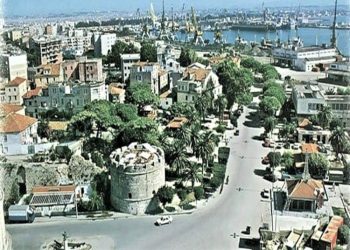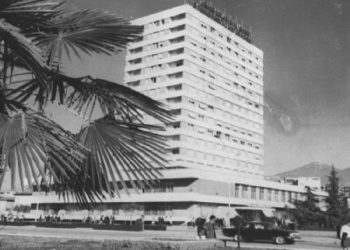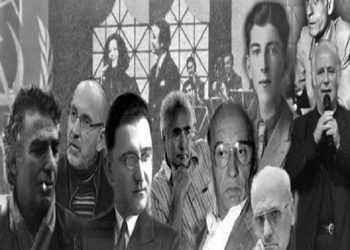
Monika Stafa *
Legends, ancient stories and writings of ancient authors show that the Illyrians and Jews settled on the two shores of the Mediterranean Sea, although they separated them for more than 2000 km, coexisted, exchanged messages of friendship and left mutual traces, which remain a source of research.
By the end of the century. of XII BC many Illyrians migrated from the Illyrian peninsula and settled in Asia Minor. Among these tribes are mentioned the Peles who settled on the southern coast of Syria, from which it is thought that the country may have taken the name Palestine. As for the tradition of the early connections of the Jews with the Illyrians it has been written only in passing and in a fragmentary manner. Despite the deserved attention that Albanian studies have paid to the presence of Hellenic, Latin or Ottoman culture, Jewish culture has been left aside for decades.
From the biblical-gospel writings, there is some initial knowledge about the apostles of early Christianity, including the apostle Paul. Among other things, it says that the first sermons were introduced to the Jewish communities in the Roman Empire, including Illyricum.
The first information about this relationship comes to our day from a legend which seen in the eyes of scholars served as a no less serious reference. The Jews, according to her, did not disappear. They took refuge in Illyria, whose population helped the slaves, who were lost Jews. Archaeological records enable us to have a Jewish presence in Illyria over a period of 15 centuries.
The discovery of the synagogue of Saranda sheds light on the existence of Jewish communities in Albania at least since the beginning of the century. VI AD. Some ruins of a synagogue found in the city of Elbasan were also discovered. Archeology professor Myzafer Korkuti writes about an ancient Jewish inscription discovered in ancient Durrës, which is preserved in the Archaeological Museum of the city. There are data on ancient Hebrew inscriptions for Shkodra, Bar, Lezha, which are historical cities with a tradition of movement at this time. Another ancient synagogue has been found in Kosovo, respectively in Ulpiana, near Prishtina, but there is no more data.
The medieval Jewish community of Durrës is mentioned for the first time during the century. XIII, when it came to Jewish families engaged in the salt trade. The data on this community belong more to the trade sphere, whereas is well known the Jews have always been famous. Later, with the change of political circumstances, the role of the Jewish community of Durrës, decreased and even more, until the beginning of the century. XV he is mentioned in the sources of the time as few in number and very impoverished.
The ordeal of the Jews, which has been escalating since the time of Roman rule, is fraught with mass migrations from their historic settlements to various countries of the West or East. Sultan Murat I (1360-1389) conquered entire regions of the Balkans but these conquests did not harm the Jewish community in these territories. The new rulers were very tolerant of the Jews and treated them honestly and much better than the orthodox rulers of the Byzantine Empire. They soon managed to learn the Turkish language by easily integrating into the social and economic life of the region. Jewish communities began to set up their own educational institutions, attracting students from all over the empire but also from other countries such as Hungary, Poland and Russia. This is a phase of the historical period in terms of the Jews of the region which is considered unique and which cannot be compared with any other period.
The contingents of Jewish refugees who arrived in the Ottoman state were not homogeneous in terms of socio-cultural affiliation. An important part of them belonged to the Ashkenazi branch, which came from the countries of Northern and Central Europe such as France, Germany, Hungary, etc. Another large contingent of immigrants from Western Europe formed the Jews of the Sephardic branch (Sephardic) originating from the Iberian Peninsula (Spain and Portugal), who after 1492, settled at the epicenter of the Jewish problem creating anti-Semitic circles of Europe.
Over the following centuries, their minds and work turned the Balkans into one of the most productive lands in the Eastern Mediterranean. The Jews engaged in trade enjoying full rights and lived and dressed in their own way without any problems. They could travel to all parts of the empire easily without paying any taxes. Gradually the Jews managed to manage the Ottoman trade, while the latter themselves politically administered the cities in general. This was a division of labor that suited both parties, so during the twentieth century. XVI, the Ottoman Empire flourished.
As can be clearly understood, the main reason for their placement, was the ease of movement for the transport of goods by steam as it cost less. Italy was at that time the main source for the Jews of Albania and Greece. In fact, compared to other Balkan cities, the Albanian ones did not have an influx of income from the community in question. We think that the reason is related to the harsh and underdeveloped economic terrain. The scholar Kostantinos Giakoumis mentions the Jews as a community in Elbasan as well. Although he does not give many details, he records as the date of their arrival in the navel of Albania, the year 1501. The presence of Jews in the city is also evidenced by the name of the old market of the city, which was known as the “Jewish Market”. The American diplomat Herman Bernstein in 1934 showed that the patriarch of the Albanian Orthodox Church, Visarion Xhuvani, had spoken to him about a large Jewish settlement many years ago in Elbasan, as well as about a large building with the Star of David that had been a synagogue and later was used by the Ottomans as an inn. The latter was known as the “Inn of Shehetila” and according to the stories of the inhabitants in its foundations, on which in 1930 the bazaar of Elbasan was built, gold coins with Hebrew signs were found.
The American ambassador further wrote that this part of Elbasan was formerly known as the residence of the Jews and that the Orthodox who lived there bore biblical names, such as Abraham, Isaac, James, etc. Later, according to Visarion, he also wrote about the help given by the Jews in the development of civilization and denounced the persecutions against them in other countries. He also mentions some parts of the old Jewish testament, which suggests that Patriarch Visarion may have been of Jewish descent living for years in Albania. The American ambassador Herman Bernstein further wrote that “in the archives of the city of Elbasan I found an old document handwritten and kept by a Turk, about 200 years ago, which was about numerous Jewish merchants who had tried to break the laws Turks and were punished by them”. Near the village of Xibraka, near Cërrik in Elbasan, on the road that leads to Belsh, there is a tomb with a stone arch called “The tomb of a Jew” which according to legend was a merchant. In the museum of Elbasan there is a pan and a copper sahan with the Star of David and Hebrew inscriptions.
In Durrës, the “metropolis of Illyricum”, a more complete consistency and continuity of the Jewish presence is proven. For its role and importance, Durrës had taken on the dimensions of a cosmopolis: there you could find foreign residents, both Byzantine and Venetian, Ragusan, Genoese, etc. The Jews could not be absent either. A document from 1417 clearly mentions a significant presence of Jews in Durrës, where a “Judaica Duracchi” is mentioned for the first time. With this name in Venice, “Judaica” were called in the Middle Ages the neighborhoods of Italian cities reserved for the Jews. In Durrës but also in Vlora and other urban centers, the Jews had the status of host or resident and not that of the citizen that the locals had. In general, there are no traces of discriminatory and anti-Semitic attitudes in Albania, as was common in Christian Europe at the time. Albanians have always been praised in documents for their tolerance of minorities. This applies to both the people and the authorities. These did not fail to bring the representatives of the Jewish community closer even to prestigious positions and positions. Here we definitely have an indicator of integration at the highest level of Jews into the domestic reality. Integration that was even more evident in other levels of civic life.
The same thing continued after the first official expulsion from the Kingdom of Naples (1510-1511), a considerable mass of Jews displaced from the territory of this kingdom, landed in many parts of the Albanian coast, focusing mainly on the city of Vlora. Newcomers either formed new communities, or joined the existing one by renewing and expanding the already shrinking ranks.
The history of the Jews of Vlora has been closely connected with that of the Jewish community of Berat. As the two main urban and administrative centers of the Vlora sanjak (have changed the role of the capital of this sanjak), the two cities, in addition to geographical proximity to each other, have had special economic ties between them. These circumstances have also determined the specific relations between the respective Jewish communities. Unlike the Jewish community of Vlora, which for the most part had its roots in western countries (Spain, Portugal, Italy), the Jews of Berat came from Vlora. The Jewish community of Berat was small, so it was enough with a single synagogue. Their presence there is confirmed by dozens of documents of the time. But how did this happen? When Vlora was attacked by a European Venetian fleet, the Jews of this city fled and went to Berat to escape the destruction of the coastal city. This led to an increase in their number in this city. Emigrants from Vlora, as well as locals, were asked to pay taxes by the Turkish authorities, but the newcomers had nothing to pay. It was then decided that they should be faced by the Jews of Berat. This caused dissatisfaction and opposition on their part. The presence of the Jewish community in Berat is associated with the name of an extraordinary figure, the famous Sabatai Zevi, the leader of a secret Jewish uprising against the Ottoman Empire, nicknamed the Messianic (by Messiah).
Although considered a deceiver by his contemporaries, he succeeded in creating the religious movement under the name “Sabatianism”. Sabatai Zevi was the spiritual leader of the Jews. He preached Judaism in secret because of persecution by the Ottoman Empire. He was captured by the Turks and sentenced to death by the sultan but this brought about great shock movements spreading to all the Jewish communities living in the Ottoman territories. This forced the High Gate to reverse its decision and expel the messianic leader of the Jews in Albania along with his family. He was sentenced to life in exile. Sabatai Zevi, forced, converted to Islam under the name Aziz Mehmed. Some foreign scholars say that he was interned in Berat where he died. Oral data show that in the neighborhood Vakëf has remained the toponym “At the grave of the Jew” referring exactly to his grave. But, from some Jewish authors who have studied his life well, it has been suggested that he may have been buried in Fterrë of Saranda or in Ulcinj. His tomb was sought to be a place of pilgrimage for Jewish believers. Understandably, his movement resonated widely throughout the Mediterranean basin as far as the Netherlands. As the Jewish scholar Gershom Gerhard Scholem proved in his study, ‘Sabbatai Zevi-The Mystical Messiah’, he along with his warriors found protection even among Albanians. He left his mark wherever he went in Albanian cities such as Vlora, Berat or Ulcinj./Memorie.al
* Detached from the author’s book “Jews in Albania”











